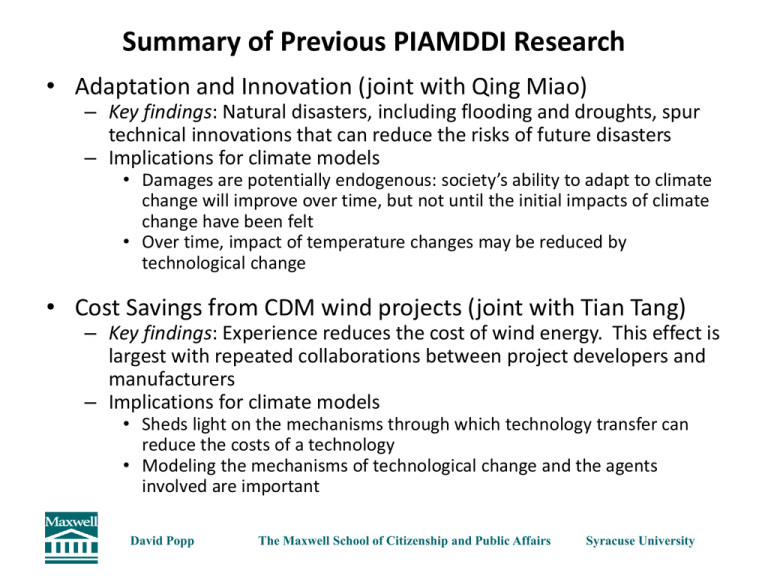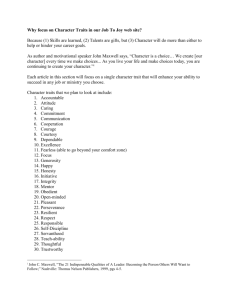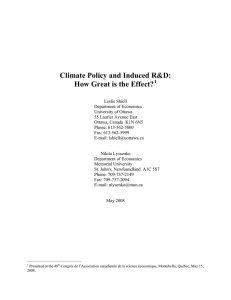Summary of Previous PIAMDDI Research
advertisement

Summary of Previous PIAMDDI Research • Adaptation and Innovation (joint with Qing Miao) – Key findings: Natural disasters, including flooding and droughts, spur technical innovations that can reduce the risks of future disasters – Implications for climate models • Damages are potentially endogenous: society’s ability to adapt to climate change will improve over time, but not until the initial impacts of climate change have been felt • Over time, impact of temperature changes may be reduced by technological change • Cost Savings from CDM wind projects (joint with Tian Tang) – Key findings: Experience reduces the cost of wind energy. This effect is largest with repeated collaborations between project developers and manufacturers – Implications for climate models • Sheds light on the mechanisms through which technology transfer can reduce the costs of a technology • Modeling the mechanisms of technological change and the agents involved are important David Popp The Maxwell School of Citizenship and Public Affairs Syracuse University Next Steps • What are the benefits of risk-mitigating innovation? – Having shown a link between disasters and innovation, we next ask what impact risk-mitigating innovations have on disaster outcomes • Part of Qing Miao’s dissertation, supported by PIAMDDI renewal – We extend the existing research on disaster resilience, which focuses on income and institutions, to consider the role of a society’s learning and innovative capacity. • Unlike local adaptations and institutions, risk-mitigating knowledge can be a global good David Popp The Maxwell School of Citizenship and Public Affairs Syracuse University Estimation Challenges and Preliminary Results • Estimation: – impacte,i,t = f(magnitudee,i,t, knowledgei,t, experiencei,t, controlsi,t) • Main challenge: – Not all natural disasters have deaths or damages associated with them – However, these are not missing at random: more likely to be missing for smaller disasters – As a result, using a selection model to consider both the probability of reported deaths or damages and the actual impact – Previous literature ignores this selection problem • Initial results using earthquakes: – Experience and own-country knowledge stocks can help reduce fatalities for larger earthquakes – Effect stronger in developed countries – Little evidence of knowledge spillovers: foreign knowledge has little effect David Popp The Maxwell School of Citizenship and Public Affairs Syracuse University Effect of knowledge and experience in earthquakes with magnitudes > 5 Assumption magnitude focal depth Ln (population exposure) l. lnGDP (l. lnGDP2)^2 l. political right l. mortality rate of children under 5 l. openness l. experience stocks l. building knowledge Constant OLS Tobit missing deaths =0 Censored Normal Heckman Selection missing deaths <= 9 1.266*** (0.180) -0.00341*** (0.00106) 0.110*** (0.0238) 0.648 (1.283) -0.0139 (0.0774) 0.147** (0.0602) 2.249*** (0.229) -0.0121*** (0.00322) 0.344*** (0.0993) 0.185 (2.143) 0.0188 (0.133) 0.246** (0.105) 1.716*** (0.211) -0.00884*** (0.00213) 0.246*** (0.0669) 1.269 (1.512) -0.0547 (0.0940) 0.155** (0.0763) 2.506*** (0.381) -0.0118*** (0.00362) 0.349*** (0.0766) 1.635 (2.276) -0.0758 (0.140) 0.237** (0.0993) 0.0851* (0.0442) -0.0163** (0.00814) -0.436*** (0.105) -0.179*** (0.0665) -17.00*** (5.861) 0.150** (0.0727) -0.0175 (0.0181) -0.528*** (0.185) -0.364*** (0.114) -29.96*** (10.22) 0.0862* (0.0473) -0.0193* (0.0114) -0.473*** (0.130) -0.201** (0.0897) -25.18*** (7.035) 0.129* (0.0762) -0.0283* (0.0152) -0.638*** (0.225) -0.309* (0.160) -35.08*** (10.65) Observations 858 858 858 Robust standard errors in parentheses Experience stock : cumulative counts of earthquakes measuring 5+ in a country; *** p<0.01, ** p<0.05, * p<0.1 858 Next Steps • Extend analysis to other sectors – Initial work focuses on earthquakes, as the data are best there – Qing plans to extend the work to flooding as part of her dissertation – Would like to extend into the agricultural sector, but will require collaboration from experts in agricultural economics who are part of the PIAMDDI team to help identify additional data sources and estimation issues unique to the agriculture sector • Potential data sources – Patents • However, patenting is mostly recent & unable to match to specific crops David Popp The Maxwell School of Citizenship and Public Affairs Syracuse University Global Patenting Trend - drought-resistant crop 350 Annual Patent Counts 300 250 200 150 100 50 0 Application year Drought-resistant crop Next Steps • Extend analysis to other sectors – Initial work focuses on earthquakes, as the data are best there – Qing plans to extend the work to flooding as part of her dissertation – Would like to extend into the agricultural sector, but will require collaboration from experts in agricultural economics who are part of the PIAMDDI team to help identify additional data sources and estimation issues unique to the agriculture sector • Potential data sources – Patents • However, patenting is mostly recent & unable to match to specific crops – Potential US data on specific crops • USDA Animal and Plant Health Inspection Service (APHIS) database – Records all biotech seed trials in US – However, only one drought-resistant seed as moved on to commercialization • USDA Current Research Information System (CRIS) – Searchable by keyword, so can obtain information on specific crops – However, only publicly funded research David Popp The Maxwell School of Citizenship and Public Affairs Syracuse University Next Steps • Are there international spillovers to adaptation R&D? – Unlike mitigation, many adaptation efforts are of a local nature – Risk-mitigating innovation may also be specialized to fit the needs of a local market • Seems particularly important for agriculture • Will use patent citation data to explore whether the knowledge spillovers from risk-mitigating innovation are comparable to those from emission-mitigating innovation • Integrating endogenous adaption into an IA model? – We will provide guidance to IA modelers who wish to incorporate endogenous adaptation into their models – Possible research questions: • What are the benefits to increasing risk-mitigating R&D before impacts occur (e.g. via government-funded R&D)? • By how much does endogenous risk-mitigation technology reduce estimated climate impacts? David Popp The Maxwell School of Citizenship and Public Affairs Syracuse University

